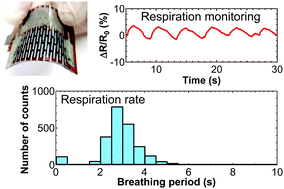Highly stable kirigami-structured stretchable strain sensors for perdurable wearable electronics†
Abstract
In wearable electronics, to acquire stability and simultaneously preserve stretchability, sensitivity, and scalability is of high significance yet challenging for practical device applications. In this work, a kirigami-structured graphene–polymer hybrid nanocomposite is proposed for strain sensors by a laser direct writing technique on a polyimide sheet. Using such kirigami structures, the strain in the sensor material can be drastically reduced in the circumstances of high stretching conditions. To protect the device, ecoflex polymer is applied as the passivation layer. Depending on the applications, ecoflex grid-wrapped and film-encapsulated devices are realized with high stretchability (>200% strain) and sensitivity (>80% resistance change at 60% strain), respectively. Significantly, this sensor platform presents almost no performance degradation even after >60 000 stretching cycle tests due to less strain within the sensor. Furthermore, as proof-of-concept for human-interactive applications, motion detection and respiration monitoring with a breathing period of 3–4 s for a comparatively long duration (>2 hours) are successfully demonstrated. These facile, scalable, highly stable and stretchable strain sensors afford a new route towards next-generation reliable skin-inspired wearable electronics.

- This article is part of the themed collection: 2019 Journal of Materials Chemistry C Most Popular Articles


 Please wait while we load your content...
Please wait while we load your content...